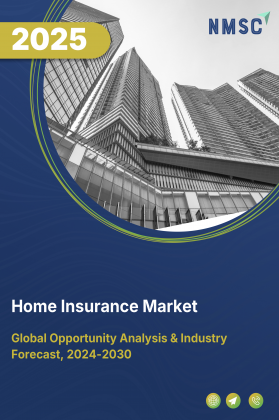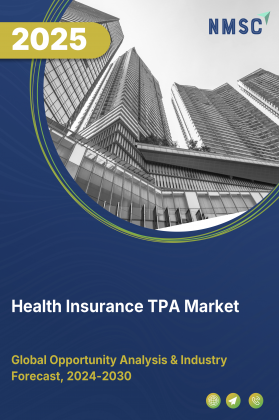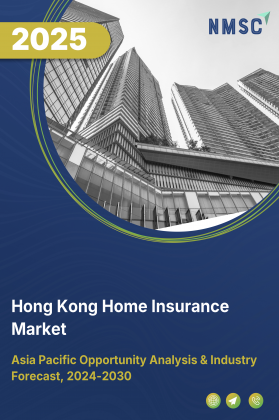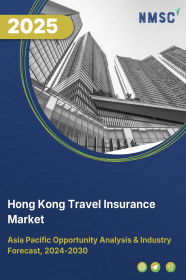
Hong Kong Travel Insurance Market by Age (Millennials, Generation X, Baby Boomers), by Income Level (Low-Income, Middle-Income, High-Income), by Coverage (Medical, Trip Cancellation, Baggage & Personal Belongings, AD&D), by Days of Coverage (Short-Trip, Standard Trip, Extended Trip, Multi-Trip), by Distribution Channel (Insurance Companies, Banks, Airlines & Others), and by End User (Pilgrim Travelers, Education Travelers & Others) – Regional Opportunity Analysis and Industry Forecast, 2025–2030
Industry: BFSI | Publish Date: 12-Sep-2025 | No of Pages: 157 | No. of Tables: 120 | No. of Figures: 65 | Format: PDF | Report Code : BF1677
Hong Kong Travel Insurance Industry Outlook
The Hong Kong Travel Insurance Market size was valued at USD 260.4 million in 2024 and is expected to reach USD 318.3 million by the end of 2025. The industry is projected to grow, hitting USD 675.4 million by 2030, with a CAGR of 16.24% between 2025 and 2030.
The travel insurance market in Hong Kong is experiencing steady growth, primarily driven by increasing outbound travel, initiatives by global key players, and the rising popularity of medical and wellness tourism. The sector is being further propelled by a surge in tourism, technological innovations, and shifting consumer preferences.
Emerging trends such as the growing focus on health, safety, and convenience are reshaping the sector. With more outbound travellers seeking comprehensive coverage and evolving travel needs, the Hong Kong travel insurance market trends is undergoing significant transformations, fuelled by advancements in technology and new customer demands.
What are the Key Trends in the Hong Kong Travel Insurance Market?
How Is the Rise of Customization and Personalized Coverage Shaping the Hong Kong Travel Insurance Market?
The growing demand for customization and personalized coverage is significantly reshaping the Hong Kong travel insurance market expansion. As travellers increasingly seek solutions that cater to their unique needs, insurers are responding by offering flexible coverage options. These customizable plans allow travellers to select specific benefits such as medical coverage, trip cancellation, or baggage loss based on their travel profiles.
This approach ensures that consumers only pay for what they need, making insurance more accessible and relevant. The shift towards personalized services is further driven by insurers leveraging data analytics to understand consumer behaviour and provide tailored packages.
Additionally, the rising popularity of solo travel, family vacations, and long-term travel has led insurers to introduce specialized products that cater to these unique travel experiences, fostering stronger customer loyalty and enhancing the market competitiveness.
How Is the Integration of Technology and Smart Insurance Solutions Driving Growth in the Hong Kong Travel Insurance Market?
The digital transformation in the market is accelerating, with insurers increasingly adopting innovative technologies to enhance customer experiences. Mobile applications, online platforms, and AI-driven tools are streamlining processes, from purchasing policies to filing claims, offering real-time policy management, claims tracking, and 24/7 support. Smart insurance solutions, such as usage-based policies and automated claims processing, are making travel insurance more accessible and efficient.
Additionally, the use of AI and data analytics enables insurers to assess risks more effectively, personalize their offerings, and enhance pricing accuracy. This integration of technology is not only transforming the market, but also driving customer engagement and fuelling industry expansion in Hong Kong.
What are the Key Market Drivers, Breakthroughs, and Investment Opportunities that will Shape the Industry in the Next Decade?
The Hong Kong travel insurance market is experiencing robust growth driven by a sharp increase in outbound travel. In 2024, Hong Kong residents' overseas departures surged, surpassing pre-pandemic levels, with a notable rise in medical and healthcare-related trips. This increase is fuelling demand for comprehensive travel insurance, especially for medical emergencies, trip cancellations, and other risks.
Additionally, frequent travel during public holidays has amplified the need for flexible and tailored insurance solutions, creating a strong market for coverage that meets evolving consumer expectations. Global market players, such as Zurich Insurance, are further driving growth through strategic partnerships and digital innovations that enhance customer experiences and streamline service offerings.
Despite this growth, the market faces significant challenges, particularly from regulatory complexities. International travel insurance providers must navigate a diverse set of regulations across different countries, increasing administrative burdens and costs. Furthermore, the high cost of compliance with licensing, consumer protection, and marketing laws hinder industry growth.
However, blockchain technology presents an exciting opportunity for the industry by improving transparency, reducing fraud, and streamlining processes. The use of decentralized ledgers and smart contracts enhance trust, reduce administrative overhead, and ensure secure and efficient claim processing, offering a path to greater market efficiency and consumer confidence.
Growth Drivers:
How Is Surging Outbound Travel Impacting the Hong Kong Travel Insurance Market?
The Hong Kong travel insurance market is witnessing substantial growth, primarily driven by the sharp rise in outbound travel. In 2024, Hong Kong residents recorded approximately 104.7 million overseas departures, marking a 10.6% increase over pre-pandemic levels in 2019 and a 45% rise compared to 2023, indicating a strong and full recovery in international travel activity.
A significant portion of these outbound trips includes travel for medical and healthcare purposes, prompting a growing reliance on travel insurance for coverage against medical emergencies abroad. Additionally, the recurring travel habits of Hong Kong citizens, especially during public holidays, have amplified the demand for comprehensive and flexible insurance products that offer protection from medical, trip cancellation, and other travel-related risks. This trend underscores the need for tailored travel insurance solutions aligned with the high travel frequency and evolving consumer expectations in the region.
How Are Global Key Market Players Driving the Growth of the Hong Kong Travel Insurance Market?
The rising initiatives by global key market players, such as those in the travel insurance sector, signify a concerted effort towards enhancing customer experiences and providing comprehensive coverage. For instance, in January 2024, Zurich Insurance collaborated with Hutchison Telecommunications Hong Kong (HTHK) aimed at bolstering digital service offerings. This collaboration entails the integration of Zurich's insurance products into HTHK's latest service brand, Domain 5, with the objective of delivering streamlined operations and enhanced customer experiences.
Growth Inhibitors:
What Regulatory Challenges Are Hindering the Growth of the Hong Kong Travel Insurance Market?
Regulatory challenges in the market include diverse and complex regulations imposed by governmental authorities across countries. Insurance providers operating internationally face significant administrative burdens and costs in ensuring compliance with these regulations, which cover aspects such as licensing, consumer protection, sales practices, and policy terms. Meeting regulatory requirements involves establishing local entities, obtaining licenses, appointing legal representatives, and adapting products and marketing strategies to align with local laws.
How Is Blockchain Technology Creating Opportunities for Growth in the Hong Kong Travel Insurance Market?
Blockchain technology offers a significant opportunity for enhancing transparency and security within the travel insurance industry. By leveraging decentralized digital ledgers, insurers establish immutable records of transactions, policies, and claims, minimizing the risk of fraud and ensuring data integrity.
Smart contracts, which automate contract execution based on predefined conditions, streamline processes such as policy issuance and claims processing, reducing administrative overhead and enhancing efficiency. The transparency provided by blockchain technology empowers insurance providers to securely access and authenticate transactional data. This transparency builds a sense of trust between insurers and policyholders.
How is the Hong Kong Travel Insurance Market Segmented in this Report, and What are the Key insights from the Segmentation Analysis?
By Age Insights
How Do Different Age Groups Shape Travel Insurance Demand?
Based on Age, the market is categorized into millennials, generation x, and baby boomers.
Age segmentation plays a crucial role in shaping Hong Kong travel insurance market, as each generation has distinct needs and preferences. Millennials (18–34), who are tech-savvy and frequent leisure travellers, prefer affordable and customizable policies purchased through mobile apps or online platforms, adding coverage for activities like adventure or extreme sports. Generation X (35–54), balancing careers and family responsibilities, typically opt for mid-to-comprehensive plans that cover dependents, trip cancellations, and family health emergencies. Baby Boomers (55+), a significant group of outbound travellers post-retirement, drive demand for long-duration policies with extensive medical coverage, particularly for chronic illnesses and pre-existing conditions. In response, insurers are increasingly designing age-specific products to effectively address these diverse requirements and expand market reach.
By Income Level Insights
How Does Income Affect Travel Insurance Purchasing Power?
Based on Income Level, the market is categorized into low-income travellers, medium-income travellers, and high-income travellers.
The high-income traveller age group constitutes a crucial segment within the Hong Kong travel insurance market, ranking as the second most dominant segment in the market. It includes travellers with substantial budget constraints who opt for premium travel insurance during their trips. This demographic comprises individuals with a higher disposable income level. Travel insurance personalized for high-income travellers offers comprehensive coverage, including benefits such as emergency medical expenses, trip cancellation and interruption, baggage loss and damage, and travel assistance services. Policies designed for this segment feature enhanced coverage limits and additional perks to accommodate their luxury travel preferences. These travellers further tend to seek insurance plans that provide extensive protection and personalized services to secure their risks associated with their affluent lifestyles.
By Coverage Insights
What Types of Coverage Are Most Sought After?
Based on Coverage, the market is categorized into trip cancellation coverage, baggage and personal belongings coverage, and accidental death and dismemberment coverage.
Coverage preferences reveal the core demand drivers. Medical coverage dominates the Hong Kong travel insurance market, driven by rising global healthcare costs and stricter entry requirements in many destinations. Trip cancellation coverage is growing in importance due to flight disruptions, political instability, and health-related uncertainties. Baggage and personal belongings coverage caters to both leisure and business travellers concerned with theft, delay, or loss of valuables. Accidental Death and Dismemberment (AD&D) coverage appeals to risk-conscious travellers, especially those engaging in business travel or high-risk activities such as skiing or trekking. The diversification of coverage types ensures insurers address both essential and niche customer needs.
By Days of Coverage Insights
How Does Trip Duration Influence Policy Selection?
Based on the Days of Coverage, the market is categorised into short trip insurance, standard trip insurance, extended trip insurance, and multi-trip insurance.
Travel duration strongly influences policy type. Short-trip insurance (up to 7 days) caters to quick getaways and weekend city breaks, especially popular among younger travellers. Standard trip insurance (8–30 days) is the most widely purchased category, covering family vacations and typical business trips. Extended trip insurance (31–90 days) appeals to international students, expatriates, and professionals on overseas assignments who require prolonged protection. Multi-trip insurance offers year-round flexibility for frequent flyers, including corporate executives and frequent leisure travellers, making it cost-effective and convenient. Duration-based segmentation helps insurers design flexible packages for both occasional and habitual travellers.
By Distribution Channel Insights
Through Which Channels Do Travelers Buy Insurance?
Based on Distribution Channel, the market is categorized into insurance companies, banks, airlines, online platforms, insurance aggregators & comparison websites, and travel agents and tour operators.
Distribution channels in Hong Kong are becoming increasingly diverse and digitalized. Traditional insurance companies and banks remain trusted providers, especially among older demographics who value reliability and in-person advisory. Airlines play a strong role by bundling policies with ticket purchases, simplifying access. Online platforms and insurance aggregators have surged in popularity, particularly with millennials, offering price comparison and instant purchase convenience. Travel agents and tour operators remain relevant, especially for families and elderly customers seeking all-inclusive packages. The shift towards digital platforms, however, signals a broader transformation in customer acquisition strategies, pushing insurers to strengthen omni-channel presence.
By End User Insights
Who Are the Key Travelers Driving Market Demand?
Based on end user, the market is categorized into pilgrim travellers, education travellers, business travellers, family travellers, and others.
End-user segmentation reflects the diverse travel purposes influencing insurance needs. Pilgrim travellers travel in groups and require collective policies covering medical emergencies and cancellations. Education travellers, particularly outbound students from Hong Kong studying overseas, are a major growth segment requiring extended medical, accident, and personal liability coverage. Business travellers demand flexible, multi-trip plans tailored for frequent international travel, integrated into corporate benefits. Family travellers represent a vital market for bundled, comprehensive plans that protect multiple members against medical, cancellation, and baggage-related risks. Insurers increasingly design products specific to travel purposes, recognizing that end-user profiles dictate both coverage type and premium appetite.
Competitive Landscape
What are the Top Companies in the Hong Kong Travel Insurance Industry, and How are they Competing Against One Another?
The travel insurance industry in Hong Kong is dominated by leading companies such as AXA CHINA, Allianz Group, HSBC Holdings PLC, BOC LIFE, AIG Insurance Hong Kong Limited, Chubb Insurance Hong Kong Limited, MANULIFE, AIA Group Limited, Zurich Insurance Group, Prudential (HK) Life, QBE Insurance Group Limited, VFS Global Group, MSIG Insurance Limited, American Express International, Inc., BOLTTECH, and others.
Hong Kong’s travel-insurance competition includes global players, AIA, AXA, Allianz, and regional powerhouses like Prudential. They leverage multichannel footprints across banks, insurers, and travel agents. Digital entrants are emerging, raising competition in short-trip and embedded models.
Innovation and Adaptability Drive Market Success
In the Hong Kong travel insurance market, success increasingly depends on digital innovation, regulatory adaptability, and consumer-centric product design. Leading players are investing in AI-enabled underwriting, instant digital claims, and flexible add-on modules tailored to different traveller types. Insurers are also adopting embedded insurance models, partnering with airlines, OTAs, and banks to capture travellers at the booking stage.
Additionally, sustainability is emerging as a competitive differentiator, with companies integrating green investment strategies and developing low-paper, mobile-first policy ecosystems to align with ESG mandates. At the same time, insurers are refining usage-based micro-policies (e.g., single-day cross-border trips to Shenzhen or Macau) to serve high-frequency, price-sensitive travellers.
Bancassurance and aggregator platforms are expanding their role as younger travellers demand convenience and instant comparison. Emerging brands disrupt by carving niches through personalized offerings for student, pilgrim, or family travel segments. Despite challenges such as price sensitivity and regulatory compliance under the new RBC framework, the demand for flexible, digitally accessible, and comprehensive travel insurance positions innovators to win market share.
Market Players to Opt for Merger & Acquisition Strategies to Expand their Presence
In the Hong Kong travel insurance market, consolidation and partnerships are accelerating as companies seek to expand both geographic reach and digital capabilities. Established insurers are pursuing alliances with regional OTAs, fintech startups, and cross-border travel operators to embed products into the Greater Bay Area’s travel ecosystem.
M&A strategies are increasingly focused on acquiring tech-driven MGAs and digital distribution platforms, providing agility and customer data insights. These acquisitions allow incumbents to respond quickly to changing traveller preferences while broadening their product portfolios beyond traditional trip-cancellation and medical coverage into value-added services like telemedicine, evacuation assistance, and ESG-aligned products.
Moreover, partnerships with health-tech startups, insurtechs, and regional tour operators further enhance reach, helping market leaders maintain competitiveness in a crowded environment. This M&A and partnership approach is proving essential to sustaining growth and differentiation in Hong Kong’s highly penetrated insurance landscape.
List of Key Hong Kong Travel Insurance Companies
-
AXA CHINA
-
Allianz Group
-
HSBC Holdings PLC
-
BOC LIFE
-
AIG Insurance Hong Kong Limited
-
Chubb Insurance Hong Kong Limited
-
MANULIFE
-
AIA Group Limited
-
Zurich Insurance Group
-
Prudential (HK) Life
-
QBE Insurance Group Limited
-
VFS Global Group
-
MSIG Insurance Limited
-
American Express International, Inc.
-
BOLTTECH
What Are the Latest Key Industry Developments?
-
August 2025 – American Express partnered with Chubb Insurance Hong Kong to underwrite its travel insurance plans, offering cardmembers benefits such as USD 128,000 in emergency medical coverage, USD 1,900 in baggage protection, and coverage for travel delays and cancellations.
-
June 2025 – Allianz Partners expanded its Hong Kong travel insurance offerings with flexible cancellation benefits, enhanced medical coverage, and improved digital support, addressing evolving traveller needs around safety, weather disruptions, and last-minute changes.
-
June 2025 – Zurich partnered with Hong Kong Airlines to embed its HKA Travel Insurance Plan into the booking process, allowing passengers to secure up to HKD 750,000 medical and HKD 20,000 trip-cancellation coverage in minutes, boosting convenience and embedded-insurance adoption.
-
April 2024 – Liberty Mutual formed Liberty International Insurance (LII), merging its specialty and retail markets under Singapore-based leadership, strengthening its Asia presence, including Hong Kong, and boosting its ability to scale travel insurance products in the region.
-
December 2024 – Manulife Hong Kong partnered with New Frontier Group to expand cross-border healthcare access, enabling policyholders to receive faster, coordinated medical care in Mainland China through New Frontier’s network.
What are the Key Factors Influencing Investment Analysis & Opportunities in the Hong Kong Travel Insurance Market?
The Hong Kong travel insurance market offers strong investment opportunities, underpinned by rising travel volumes, increasing disposable incomes, and the shift toward digital-first insurance models. Demand for comprehensive, medical-focused policies is expanding as consumers prioritize safety and convenience.
Growth in embedded distribution partnerships with airlines, OTAs, and banks creates scalable channels to capture customers at the point of booking, while investments in AI-driven underwriting, telemedicine, and instant claims processing strengthen competitive differentiation. Insurtech platforms and mobile ecosystems further enable insurers to reach younger, tech-savvy travellers efficiently.
At the same time, regulatory and sustainability factors are reshaping the investment landscape. The Risk-Based Capital (RBC) framework, launched in 2024, enhances transparency and capital efficiency, favouring insurers with robust solvency and product innovation.
Companies aligning with ESG priorities, cross-border partnerships, and niche traveller segments are well-positioned for growth. For investors, opportunities lie in backing digitally agile insurers, MGAs, and tech-driven alliances, where flexibility and compliance converge with the rising demand for customizable, accessible travel insurance solutions.
Key Benefits for Stakeholders:
Next Move Strategy Consulting (NMSC) presents a comprehensive analysis of the Hong Kong travel insurance market, covering historical trends from 2020 through 2024 and offering detailed forecasts through 2030. Our study examines the market at global, regional, and country levels, providing quantitative projections and insights into key growth drivers, challenges, and investment opportunities across all major travel insurance segments.
Report Scope:
|
Parameters |
Details |
|
Market Size in 2025 |
USD 318.3 million |
|
Revenue Forecast in 2030 |
USD 675.4 million |
|
Growth Rate |
CAGR of 16.24% from 2025 to 2030 |
|
Analysis Period |
2024–2030 |
|
Base Year Considered |
2024 |
|
Forecast Period |
2025–2030 |
|
Market Size Estimation |
Million (USD) |
|
Growth Factors |
|
|
Companies Profiled |
15 |
|
Market Share |
Available for 10 companies |
|
Customization Scope |
Free customization (equivalent up to 80 analyst-working hours) after purchase. Addition or alteration to country, regional & segment scope. |
|
Pricing and Purchase Options |
Avail customized purchase options to meet your exact research needs. |
|
Approach |
In-depth primary and secondary research; proprietary databases; rigorous quality control and validation measures. |
|
Analytical Tools |
Porter's Five Forces, SWOT, value chain, and Harvey ball analysis to assess competitive intensity, stakeholder roles, and relative impact of key factors. |
Key Market Segments
By Age
-
Millennials (18–34)
-
Generation X (35–54)
-
Baby Boomers (55+)
By Income Level
-
Low-Income Travelers
-
Middle-Income Travelers
-
High-Income Travelers
By Coverage
-
Medical Coverage
-
Trip Cancellation Coverage
-
Baggage and Personal Belongings Coverage
-
Accidental Death and Dismemberment (AD&D) Coverage
By Days of Coverage
-
Short-Trip Insurance (up to 7 days)
-
Standard Trip Insurance (8–30 days)
-
Extended Trip Insurance (31–90 days)
-
Multi-Trip Insurance (up to 90 days/trip)
By Distribution Channel
-
Insurance Companies
-
Banks
-
Airlines
-
Online Platforms
-
Insurance Aggregators and Comparison Websites
-
Travel Agents and Tour Operators
By End User
-
Pilgrim Travelers
-
Education Travelers
-
Business Travelers
-
Family Travelers
Conclusion & Recommendations
Our report equips stakeholders, industry participants, investors, policy makers, and consultants with actionable intelligence to capitalize on the dynamic growth of the Hong Kong Travel Insurance Market. By combining comprehensive, data driven analysis with strategic insights and market frameworks, NMSC’s Hong Kong Travel Insurance Market Report serves as an indispensable resource for navigating evolving consumer preferences, regulatory shifts, and competitive dynamics.
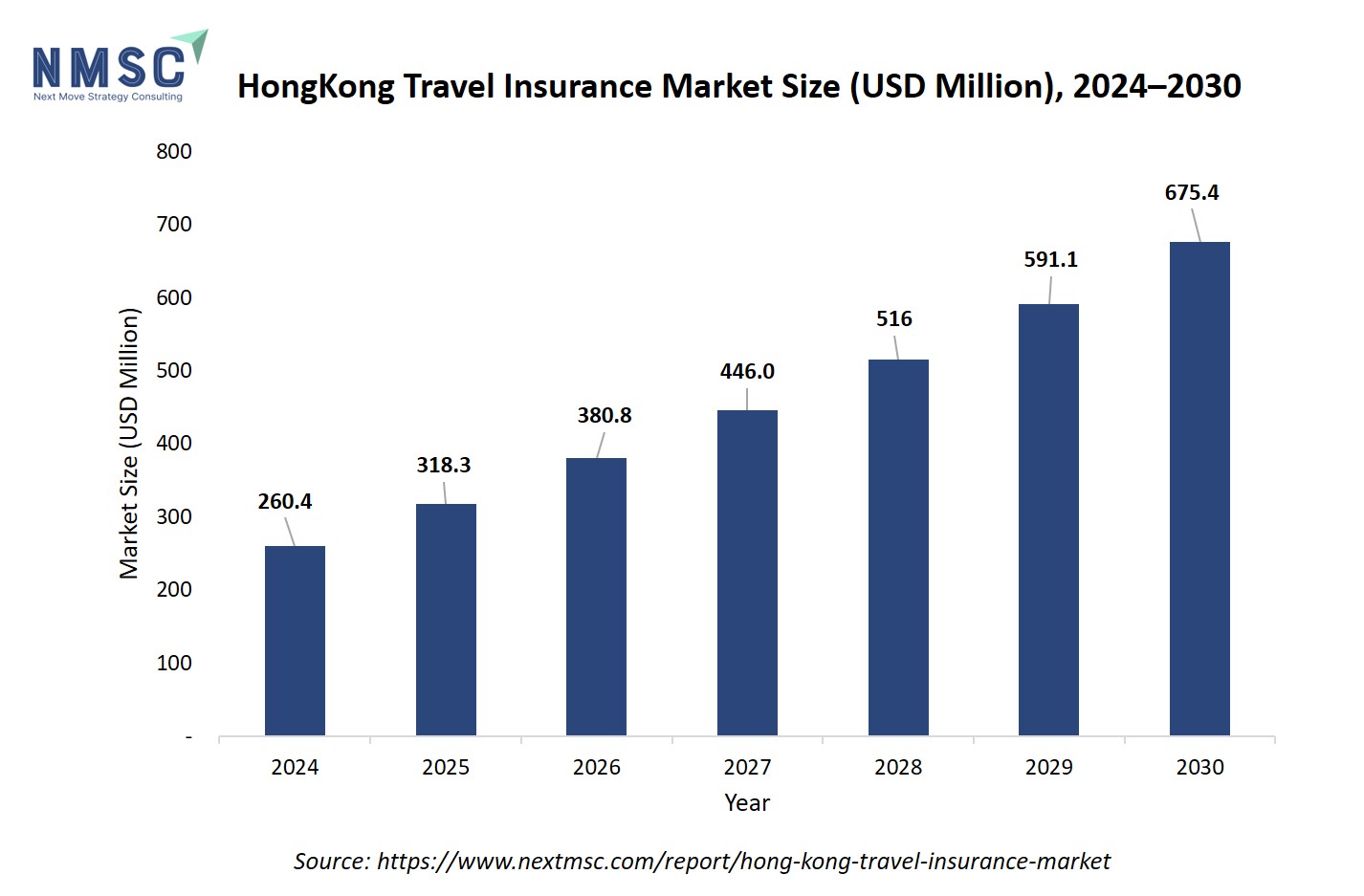

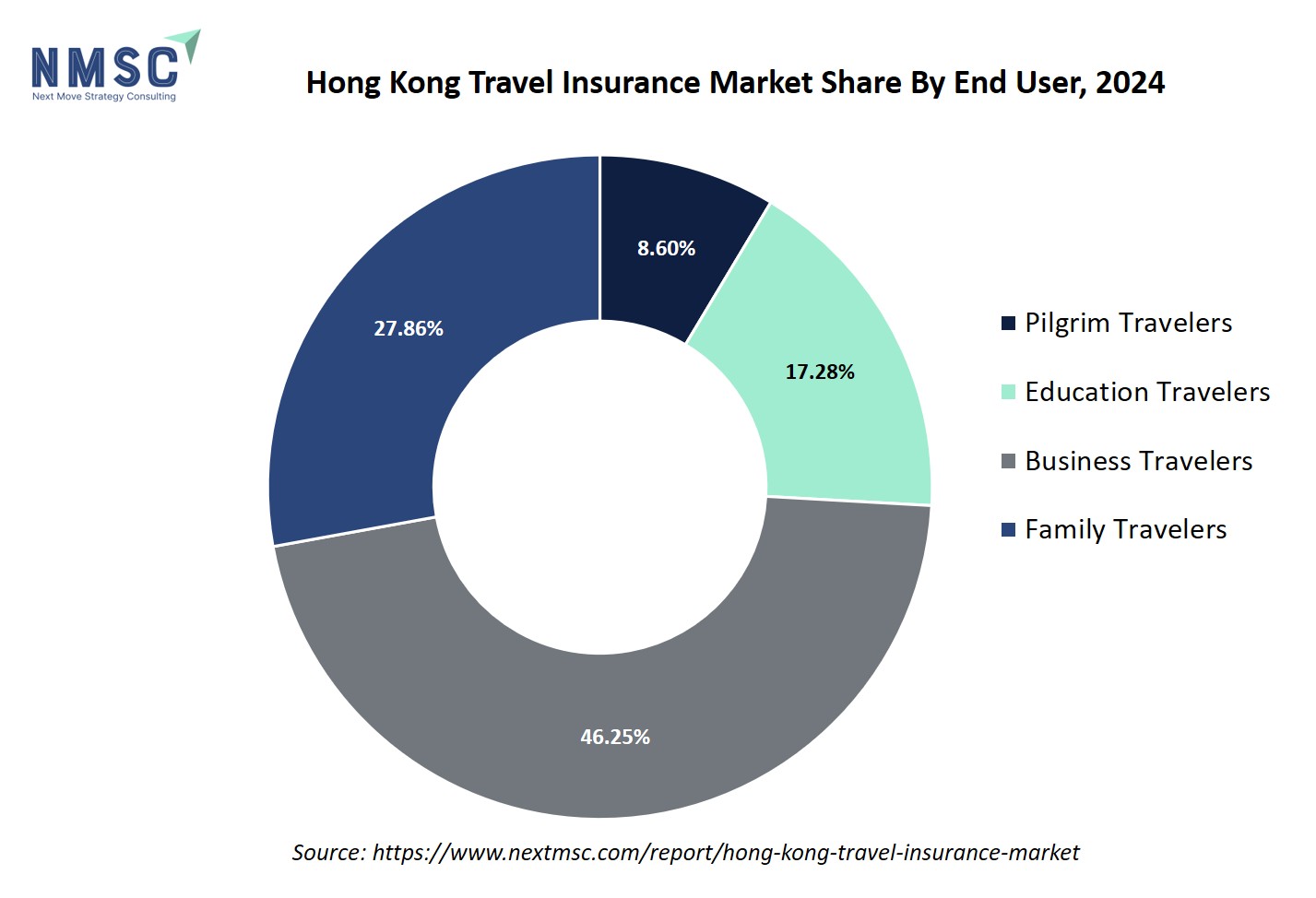
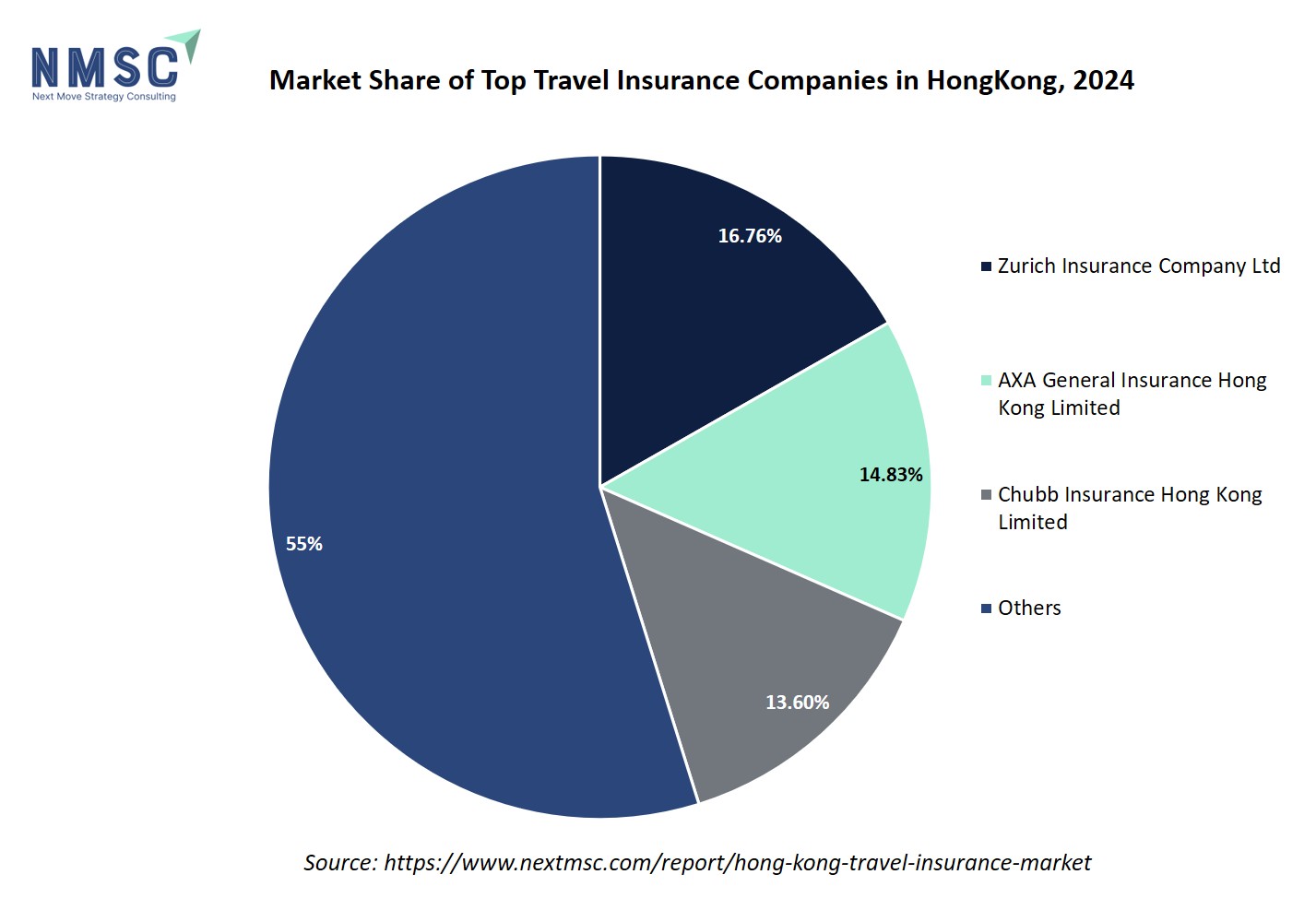

















 Speak to Our Analyst
Speak to Our Analyst



